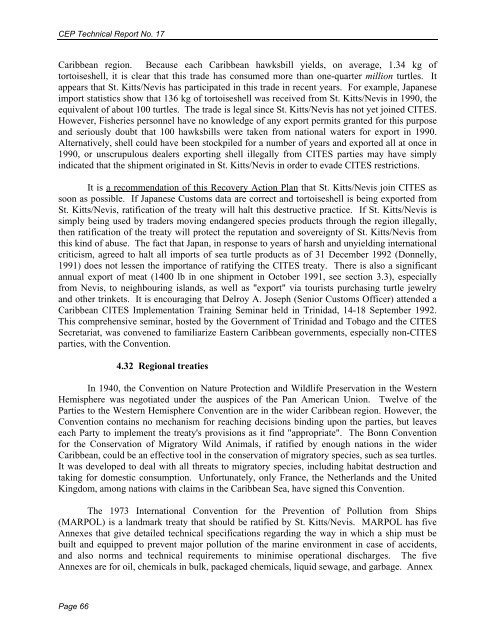Sea Turtle Recovery Action Plan for St. Kitts and Nevis - WIDECAST
Sea Turtle Recovery Action Plan for St. Kitts and Nevis - WIDECAST
Sea Turtle Recovery Action Plan for St. Kitts and Nevis - WIDECAST
Create successful ePaper yourself
Turn your PDF publications into a flip-book with our unique Google optimized e-Paper software.
CEP Technical Report No. 17<br />
Caribbean region. Because each Caribbean hawksbill yields, on average, 1.34 kg of<br />
tortoiseshell, it is clear that this trade has consumed more than one-quarter million turtles. It<br />
appears that <strong>St</strong>. <strong>Kitts</strong>/<strong>Nevis</strong> has participated in this trade in recent years. For example, Japanese<br />
import statistics show that 136 kg of tortoiseshell was received from <strong>St</strong>. <strong>Kitts</strong>/<strong>Nevis</strong> in 1990, the<br />
equivalent of about 100 turtles. The trade is legal since <strong>St</strong>. <strong>Kitts</strong>/<strong>Nevis</strong> has not yet joined CITES.<br />
However, Fisheries personnel have no knowledge of any export permits granted <strong>for</strong> this purpose<br />
<strong>and</strong> seriously doubt that 100 hawksbills were taken from national waters <strong>for</strong> export in 1990.<br />
Alternatively, shell could have been stockpiled <strong>for</strong> a number of years <strong>and</strong> exported all at once in<br />
1990, or unscrupulous dealers exporting shell illegally from CITES parties may have simply<br />
indicated that the shipment originated in <strong>St</strong>. <strong>Kitts</strong>/<strong>Nevis</strong> in order to evade CITES restrictions.<br />
It is a recommendation of this <strong>Recovery</strong> <strong>Action</strong> <strong>Plan</strong> that <strong>St</strong>. <strong>Kitts</strong>/<strong>Nevis</strong> join CITES as<br />
soon as possible. If Japanese Customs data are correct <strong>and</strong> tortoiseshell is being exported from<br />
<strong>St</strong>. <strong>Kitts</strong>/<strong>Nevis</strong>, ratification of the treaty will halt this destructive practice. If <strong>St</strong>. <strong>Kitts</strong>/<strong>Nevis</strong> is<br />
simply being used by traders moving endangered species products through the region illegally,<br />
then ratification of the treaty will protect the reputation <strong>and</strong> sovereignty of <strong>St</strong>. <strong>Kitts</strong>/<strong>Nevis</strong> from<br />
this kind of abuse. The fact that Japan, in response to years of harsh <strong>and</strong> unyielding international<br />
criticism, agreed to halt all imports of sea turtle products as of 31 December 1992 (Donnelly,<br />
1991) does not lessen the importance of ratifying the CITES treaty. There is also a significant<br />
annual export of meat (1400 lb in one shipment in October 1991, see section 3.3), especially<br />
from <strong>Nevis</strong>, to neighbouring isl<strong>and</strong>s, as well as "export" via tourists purchasing turtle jewelry<br />
<strong>and</strong> other trinkets. It is encouraging that Delroy A. Joseph (Senior Customs Officer) attended a<br />
Caribbean CITES Implementation Training Seminar held in Trinidad, 14-18 September 1992.<br />
This comprehensive seminar, hosted by the Government of Trinidad <strong>and</strong> Tobago <strong>and</strong> the CITES<br />
Secretariat, was convened to familiarize Eastern Caribbean governments, especially non-CITES<br />
parties, with the Convention.<br />
4.32 Regional treaties<br />
In 1940, the Convention on Nature Protection <strong>and</strong> Wildlife Preservation in the Western<br />
Hemisphere was negotiated under the auspices of the Pan American Union. Twelve of the<br />
Parties to the Western Hemisphere Convention are in the wider Caribbean region. However, the<br />
Convention contains no mechanism <strong>for</strong> reaching decisions binding upon the parties, but leaves<br />
each Party to implement the treaty's provisions as it find "appropriate". The Bonn Convention<br />
<strong>for</strong> the Conservation of Migratory Wild Animals, if ratified by enough nations in the wider<br />
Caribbean, could be an effective tool in the conservation of migratory species, such as sea turtles.<br />
It was developed to deal with all threats to migratory species, including habitat destruction <strong>and</strong><br />
taking <strong>for</strong> domestic consumption. Un<strong>for</strong>tunately, only France, the Netherl<strong>and</strong>s <strong>and</strong> the United<br />
Kingdom, among nations with claims in the Caribbean <strong>Sea</strong>, have signed this Convention.<br />
The 1973 International Convention <strong>for</strong> the Prevention of Pollution from Ships<br />
(MARPOL) is a l<strong>and</strong>mark treaty that should be ratified by <strong>St</strong>. <strong>Kitts</strong>/<strong>Nevis</strong>. MARPOL has five<br />
Annexes that give detailed technical specifications regarding the way in which a ship must be<br />
built <strong>and</strong> equipped to prevent major pollution of the marine environment in case of accidents,<br />
<strong>and</strong> also norms <strong>and</strong> technical requirements to minimise operational discharges. The five<br />
Annexes are <strong>for</strong> oil, chemicals in bulk, packaged chemicals, liquid sewage, <strong>and</strong> garbage. Annex<br />
Page 66
















